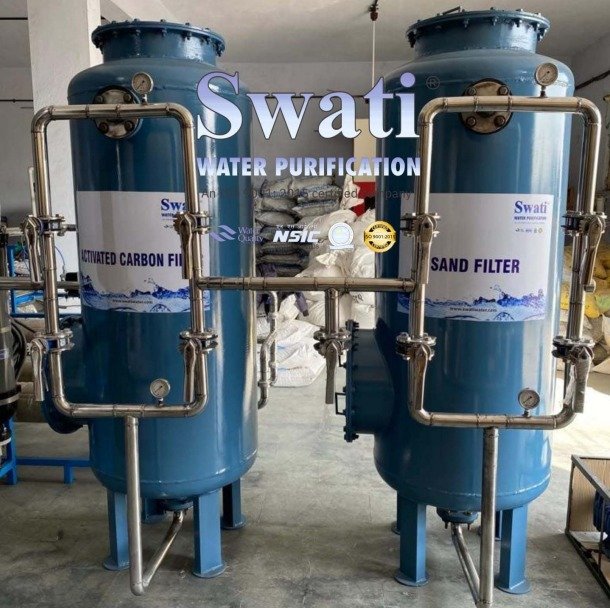Primary Industrial Water Treatment Plant
Swati Water Purification – Primary Industrial Water Treatment Plant Supplier, Primary Industrial Water Treatment Plant Manufacturer.

Primary Industrial Water Treatment Plant
A Primary Industrial Water Treatment Plant refers to the first stage of water treatment used in industrial processes to remove large particles and contaminants from water before it enters more advanced treatment stages. In industrial settings, water can become contaminated with a variety of substances, including oils, chemicals, suspended solids and organic matter, depending on the type of industry (e.g., manufacturing, food processing, pharmaceuticals etc.). The Primary treatment aims to reduce the concentration of these contaminates by using physical and chemical processes.
Primary Industrial Water Treatment Plant Also known as, “Primary Effluent Treatment Plant (ETP),” “Industrial Wastewater Treatment Plant,” “Pre-Treatment Plant,” “Preliminary Water Treatment Plant,” “Primary Filtration System,” “Raw Water treatment Plant,” “Wastewater Treatment Plant (WWTP),” “Water Recycling Center Or Water Reclamation Plants.”
We Are Manufacturers & Suppliers In Ahmedabad, Gandhinagar, Gujarat, India, Sanand GIDC, Mehsana, Vitthalapur, Mandal Bechraji Special Investment Region(MBSIR), Halol GIDC, Bavla Kerala GIDC, Dahej SIR & PCPIR(Petroleum, Chemicals and Petrochemicals Investment Region), Dholera SIR, GIDC Industrial Area(Gujarat Industrial Development Corporation), MIDC Industrial Area(Maharashtra Industrial Development Corporation), MPIDC Industrial Area(Madhya Pradesh Industrial Development Corporation), RIICO Industrial Area(Rajasthan State Industrial Development & Investment Corporation), PSIDC(Punjab State Industrial Development Corporation), SEZs Area(Special Economic Zones), SEEZ Area(Solar Energy Enterprises Zone) In Rajasthan, Peenya Industrial Area In Bengaluru(Bengalore, Karnataka) etc..
Capacities Of Primary Industrial Water Treatment Plant:
- Small-Scale Plants: 10 to 100 KLD (for small factories or commercial units).
- Medium-Scale Plants: 100 to 1,000 KLD (for medium-sized industries like textiles, food processing or pharmaceuticals and hotels).
- Large-Scale Plants: 1,000 to 10,000 KLD (for larger industrial operations such as chemical plants or power stations).
- Very Large-Scale Plants: 10,000 KLD or More (for major industrial complexes or large manufacturing units).
The Capacity depends on factors such as the water usage, contamination levels and specific industrial requirements.
How to Work:
1. Screening: Wastewater passes through screens that capture large particles, debris and trash (such as plastic rags, etc.)
2. Grit Removal: The water then moves to a grit chamber where heavier particles like sand, gravel and silt settle at the bottom due to gravity.
3. Sedimentation: In the settling tank (also called a clarifier) remaining suspended solids settle out as sludge. This process is aided by gravity, allowing solids to separate from the water.
4. Skimming: Any oils, Grease or floating debris are skimmed off the surface of the water.
5. Sludge Collection: The Collected sludge from sedimentation and skimming is then removed for further treatment or disposal.
The goal of primary treatment is to reduce the load of solids, oils and debris before the water undergoes secondary treatment (like biological treatment or filtration).
Applications of Primary Water Treatment Plant:
1. Textile Industry: Removes suspended solids and large particles from wastewater before further treatment.
2. Food & beverage Industry: Pre-treats wastewater to remove organic solids, oil and grease.
3. Pharmaceutical Industry: Filters and clarifiers water, removing particulates and contaminants.
4. Chemical Manufacturing: Reduces large debris and chemicals, protecting downstream treatment processes.
5. Paper & Pulp Industry: Removes fibers, chemicals and solids from the wastewater to protect equipment and ensure better treatment.
6. Metal & Mining Industries: Removes metal particles and solids from wastewater before further treatment or reuse.
7. Power Plants: Pre-treats cooling water and wastewater removing large debris before treatment in secondary processes.
8. Textile Industry: Removes fibers, lint and large contaminants from water used in dyeing, washing and rinsing.
9. Mining: Pre-treats wastewater by removing heavy solids before further processing to reduce environmental contamination.
Primary Treatment focuses on removing large solids and debris from industrial wastewater to reduce the load on secondary treatment processes.
